2007 CHEVROLET HHR stop start
[x] Cancel search: stop startPage 256 of 446
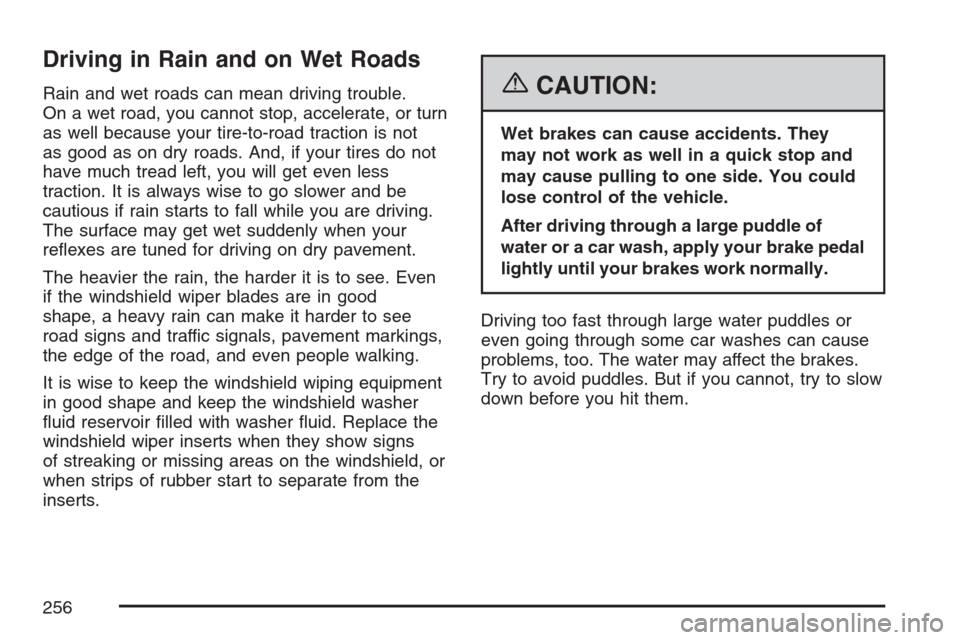
Driving in Rain and on Wet Roads
Rain and wet roads can mean driving trouble.
On a wet road, you cannot stop, accelerate, or turn
as well because your tire-to-road traction is not
as good as on dry roads. And, if your tires do not
have much tread left, you will get even less
traction. It is always wise to go slower and be
cautious if rain starts to fall while you are driving.
The surface may get wet suddenly when your
re�exes are tuned for driving on dry pavement.
The heavier the rain, the harder it is to see. Even
if the windshield wiper blades are in good
shape, a heavy rain can make it harder to see
road signs and traffic signals, pavement markings,
the edge of the road, and even people walking.
It is wise to keep the windshield wiping equipment
in good shape and keep the windshield washer
�uid reservoir �lled with washer �uid. Replace the
windshield wiper inserts when they show signs
of streaking or missing areas on the windshield, or
when strips of rubber start to separate from the
inserts.{CAUTION:
Wet brakes can cause accidents. They
may not work as well in a quick stop and
may cause pulling to one side. You could
lose control of the vehicle.
After driving through a large puddle of
water or a car wash, apply your brake pedal
lightly until your brakes work normally.
Driving too fast through large water puddles or
even going through some car washes can cause
problems, too. The water may affect the brakes.
Try to avoid puddles. But if you cannot, try to slow
down before you hit them.
256
Page 260 of 446
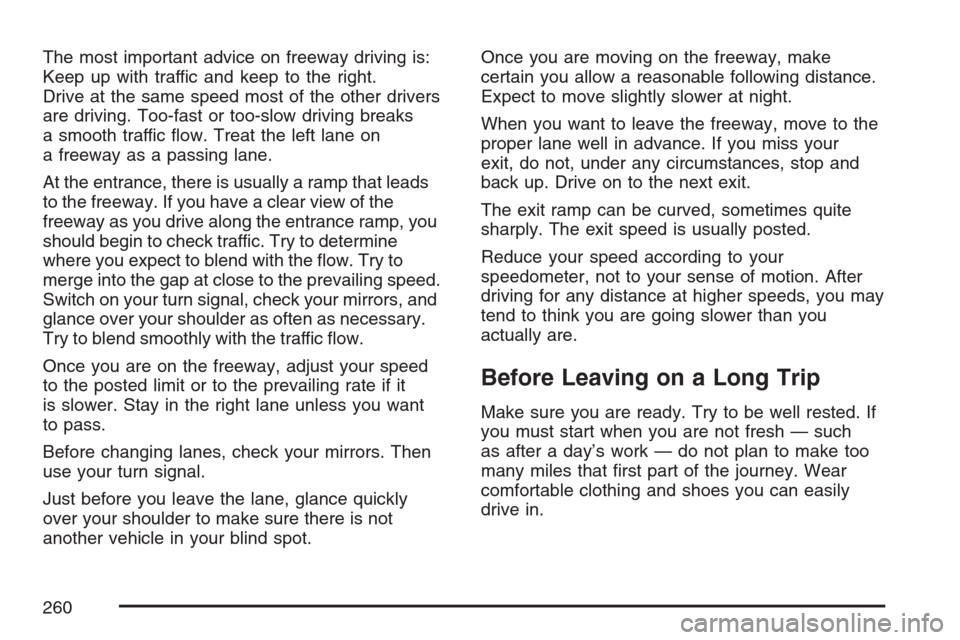
The most important advice on freeway driving is:
Keep up with traffic and keep to the right.
Drive at the same speed most of the other drivers
are driving. Too-fast or too-slow driving breaks
a smooth traffic �ow. Treat the left lane on
a freeway as a passing lane.
At the entrance, there is usually a ramp that leads
to the freeway. If you have a clear view of the
freeway as you drive along the entrance ramp, you
should begin to check traffic. Try to determine
where you expect to blend with the �ow. Try to
merge into the gap at close to the prevailing speed.
Switch on your turn signal, check your mirrors, and
glance over your shoulder as often as necessary.
Try to blend smoothly with the traffic �ow.
Once you are on the freeway, adjust your speed
to the posted limit or to the prevailing rate if it
is slower. Stay in the right lane unless you want
to pass.
Before changing lanes, check your mirrors. Then
use your turn signal.
Just before you leave the lane, glance quickly
over your shoulder to make sure there is not
another vehicle in your blind spot.Once you are moving on the freeway, make
certain you allow a reasonable following distance.
Expect to move slightly slower at night.
When you want to leave the freeway, move to the
proper lane well in advance. If you miss your
exit, do not, under any circumstances, stop and
back up. Drive on to the next exit.
The exit ramp can be curved, sometimes quite
sharply. The exit speed is usually posted.
Reduce your speed according to your
speedometer, not to your sense of motion. After
driving for any distance at higher speeds, you may
tend to think you are going slower than you
actually are.
Before Leaving on a Long Trip
Make sure you are ready. Try to be well rested. If
you must start when you are not fresh — such
as after a day’s work — do not plan to make too
many miles that �rst part of the journey. Wear
comfortable clothing and shoes you can easily
drive in.
260
Page 286 of 446
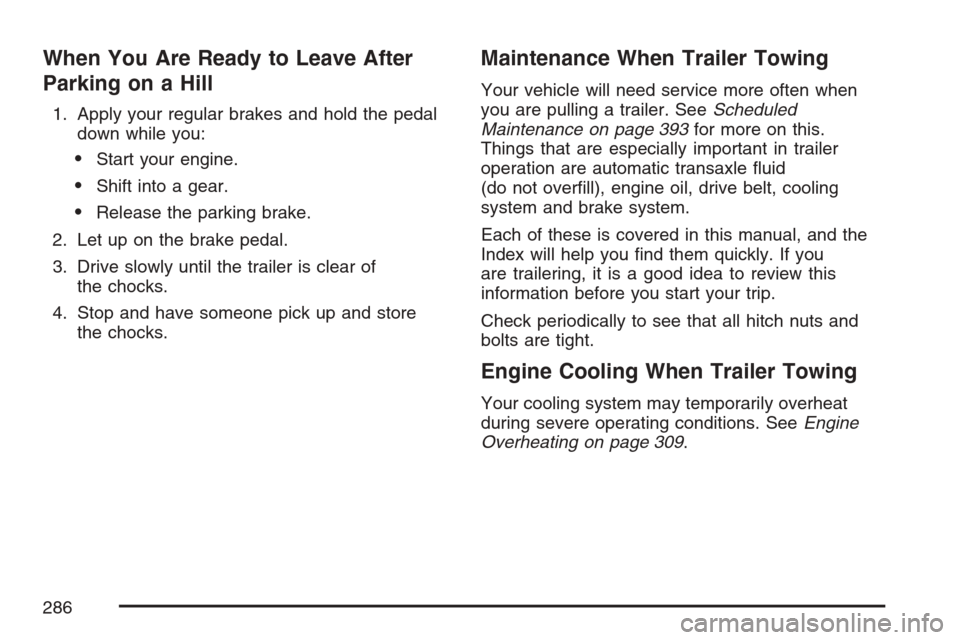
When You Are Ready to Leave After
Parking on a Hill
1. Apply your regular brakes and hold the pedal
down while you:
Start your engine.
Shift into a gear.
Release the parking brake.
2. Let up on the brake pedal.
3. Drive slowly until the trailer is clear of
the chocks.
4. Stop and have someone pick up and store
the chocks.
Maintenance When Trailer Towing
Your vehicle will need service more often when
you are pulling a trailer. SeeScheduled
Maintenance on page 393for more on this.
Things that are especially important in trailer
operation are automatic transaxle �uid
(do not over�ll), engine oil, drive belt, cooling
system and brake system.
Each of these is covered in this manual, and the
Index will help you �nd them quickly. If you
are trailering, it is a good idea to review this
information before you start your trip.
Check periodically to see that all hitch nuts and
bolts are tight.
Engine Cooling When Trailer Towing
Your cooling system may temporarily overheat
during severe operating conditions. SeeEngine
Overheating on page 309.
286
Page 287 of 446

Service........................................................ 289
Accessories and Modi�cations................... 289
California Proposition 65 Warning.............. 290
Doing Your Own Service Work.................. 290
Adding Equipment to the Outside of
Your Vehicle.......................................... 291
Fuel............................................................. 291
Gasoline Octane........................................ 291
Gasoline Speci�cations.............................. 292
California Fuel........................................... 292
Additives................................................... 292
Fuels in Foreign Countries........................ 293
Filling the Tank......................................... 294
Filling a Portable Fuel Container............... 296
Checking Things Under the Hood.............. 296
Hood Release........................................... 297
Engine Compartment Overview.................. 298
Engine Oil................................................. 299
Engine Oil Life System.............................. 302
Engine Air Cleaner/Filter............................ 304
Automatic Transaxle Fluid......................... 305
Manual Transaxle Fluid............................. 305
Hydraulic Clutch........................................ 306
Engine Coolant.......................................... 306Pressure Cap............................................ 309
Engine Overheating................................... 309
Cooling System......................................... 312
Windshield Washer Fluid........................... 316
Brakes...................................................... 317
Battery...................................................... 320
Jump Starting............................................ 320
Headlamp Aiming........................................ 327
Bulb Replacement....................................... 330
Halogen Bulbs........................................... 330
Headlamps, Front Turn Signal, and
Parking Lamps....................................... 330
Center High-Mounted Stoplamp (CHMSL) ... 331
Taillamps, Turn Signal, Stoplamps and
Back-up Lamps...................................... 332
License Plate Lamp................................... 334
Replacement Bulbs................................... 334
Windshield Wiper Blade Replacement....... 335
Tires............................................................ 336
Tire Sidewall Labeling............................... 337
Tire Terminology and De�nitions............... 340
In�ation - Tire Pressure............................. 344
Tire Inspection and Rotation...................... 345
Section 5 Service and Appearance Care
287
Page 295 of 446
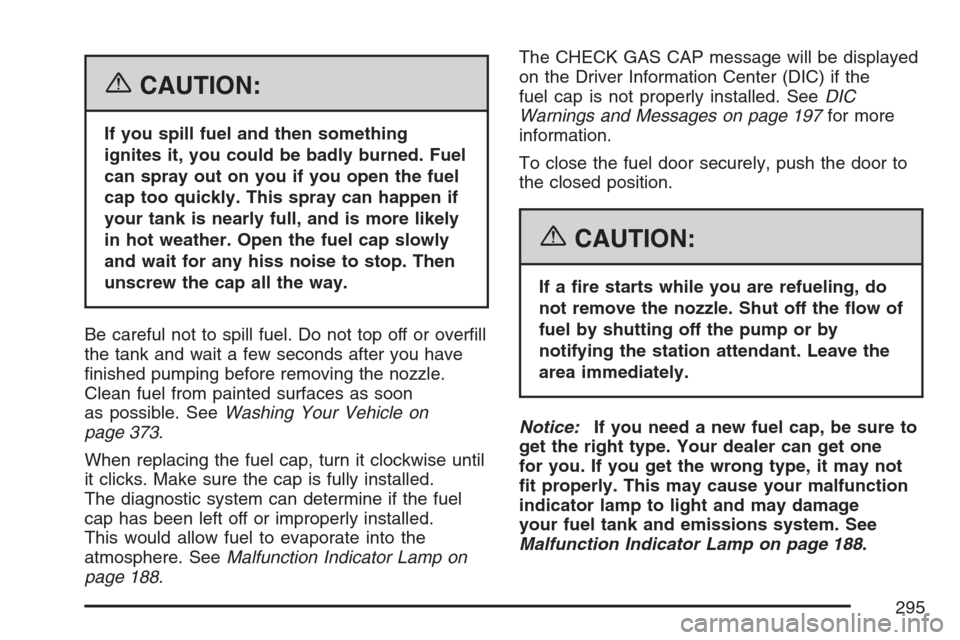
{CAUTION:
If you spill fuel and then something
ignites it, you could be badly burned. Fuel
can spray out on you if you open the fuel
cap too quickly. This spray can happen if
your tank is nearly full, and is more likely
in hot weather. Open the fuel cap slowly
and wait for any hiss noise to stop. Then
unscrew the cap all the way.
Be careful not to spill fuel. Do not top off or over�ll
the tank and wait a few seconds after you have
�nished pumping before removing the nozzle.
Clean fuel from painted surfaces as soon
as possible. SeeWashing Your Vehicle on
page 373.
When replacing the fuel cap, turn it clockwise until
it clicks. Make sure the cap is fully installed.
The diagnostic system can determine if the fuel
cap has been left off or improperly installed.
This would allow fuel to evaporate into the
atmosphere. SeeMalfunction Indicator Lamp on
page 188.The CHECK GAS CAP message will be displayed
on the Driver Information Center (DIC) if the
fuel cap is not properly installed. SeeDIC
Warnings and Messages on page 197for more
information.
To close the fuel door securely, push the door to
the closed position.
{CAUTION:
If a �re starts while you are refueling, do
not remove the nozzle. Shut off the �ow of
fuel by shutting off the pump or by
notifying the station attendant. Leave the
area immediately.
Notice:If you need a new fuel cap, be sure to
get the right type. Your dealer can get one
for you. If you get the wrong type, it may not
�t properly. This may cause your malfunction
indicator lamp to light and may damage
your fuel tank and emissions system. See
Malfunction Indicator Lamp on page 188.
295
Page 444 of 446
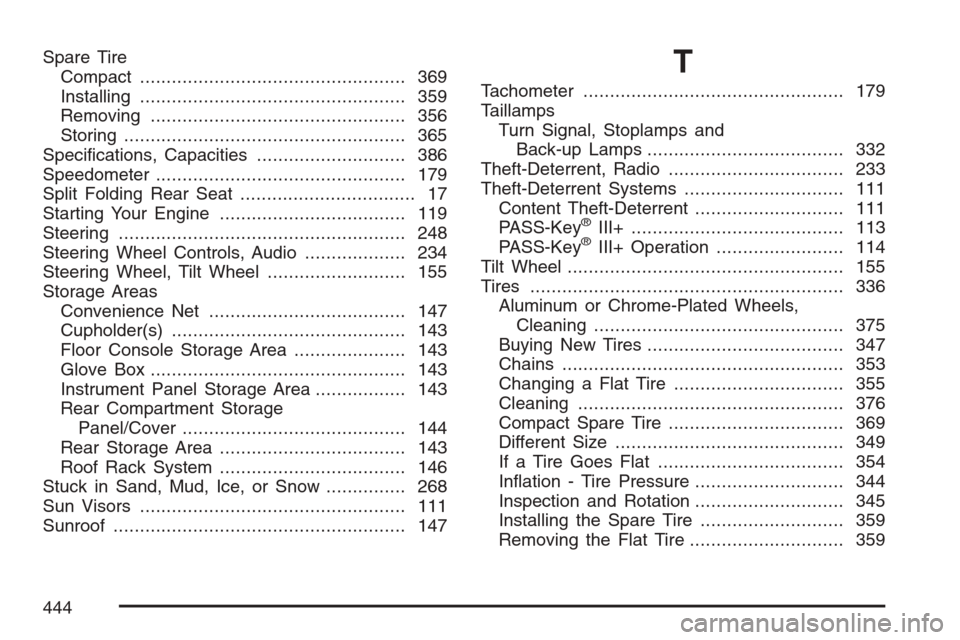
Spare Tire
Compact.................................................. 369
Installing.................................................. 359
Removing................................................ 356
Storing..................................................... 365
Speci�cations, Capacities............................ 386
Speedometer............................................... 179
Split Folding Rear Seat................................. 17
Starting Your Engine................................... 119
Steering...................................................... 248
Steering Wheel Controls, Audio................... 234
Steering Wheel, Tilt Wheel.......................... 155
Storage Areas
Convenience Net..................................... 147
Cupholder(s)............................................ 143
Floor Console Storage Area..................... 143
Glove Box................................................ 143
Instrument Panel Storage Area................. 143
Rear Compartment Storage
Panel/Cover.......................................... 144
Rear Storage Area................................... 143
Roof Rack System................................... 146
Stuck in Sand, Mud, Ice, or Snow............... 268
Sun Visors.................................................. 111
Sunroof....................................................... 147T
Tachometer................................................. 179
Taillamps
Turn Signal, Stoplamps and
Back-up Lamps..................................... 332
Theft-Deterrent, Radio................................. 233
Theft-Deterrent Systems.............................. 111
Content Theft-Deterrent............................ 111
PASS-Key
®III+........................................ 113
PASS-Key®III+ Operation........................ 114
Tilt Wheel.................................................... 155
Tires........................................................... 336
Aluminum or Chrome-Plated Wheels,
Cleaning............................................... 375
Buying New Tires..................................... 347
Chains..................................................... 353
Changing a Flat Tire................................ 355
Cleaning.................................................. 376
Compact Spare Tire................................. 369
Different Size........................................... 349
If a Tire Goes Flat................................... 354
In�ation - Tire Pressure............................ 344
Inspection and Rotation............................ 345
Installing the Spare Tire........................... 359
Removing the Flat Tire............................. 359
444